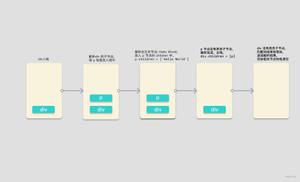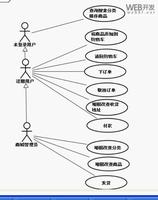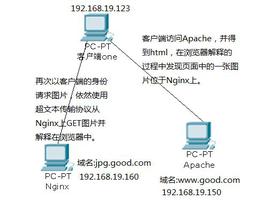JAVA Vector源码解析和示例代码
第1部分 Vector介绍Vector 是矢量队列,它是JDK1.0版本添加的类。继承于AbstractList,实现了List, RandomAccess, Cloneable这些接口。Vector 继承了AbstractList,实现了List;所以,它是一个队列,支持相关的添加、删除、修改、遍历等功能。Vector 实现了RandmoAccess接口,即提供了随机访问功能。RandmoAccess是java中用来被List实现,为List提供快速访问功能的。在Vector中,我们即可以通过元素的序号快速获取元素对象;这就是快速随机访问。Vector 实现了Cloneable接口,即实现clone()函数。它能被克隆。和ArrayList不同,Vector中的操作是线程安全的;但是,Vector不支持序列化,即没有实现java.io.Serializable接口。Vector的继承关系
// 从index位置开始向后查找元素(o)。 // 若找到,则返回元素的索引值;否则,返回-1 public synchronized int indexOf(Object o, int index) { if (o == null) { // 若查找元素为null,则正向找出null元素,并返回它对应的序号 for (int i = index ; i < elementCount ; i++) if (elementData[i]==null) return i; } else { // 若查找元素不为null,则正向找出该元素,并返回它对应的序号 for (int i = index ; i < elementCount ; i++) if (o.equals(elementData[i])) return i; } return -1; } // 查找并返回元素(o)在Vector中的索引值 public int indexOf(Object o) { return indexOf(o, 0); } // 从后向前查找元素(o)。并返回元素的索引 public synchronized int lastIndexOf(Object o) { return lastIndexOf(o, elementCount-1); } // 从后向前查找元素(o)。开始位置是从前向后的第index个数; // 若找到,则返回元素的“索引值”;否则,返回-1。 public synchronized int lastIndexOf(Object o, int index) { if (index >= elementCount) throw new IndexOutOfBoundsException(index + " >= "+ elementCount); if (o == null) { // 若查找元素为null,则反向找出null元素,并返回它对应的序号 for (int i = index; i >= 0; i--) if (elementData[i]==null) return i; } else { // 若查找元素不为null,则反向找出该元素,并返回它对应的序号 for (int i = index; i >= 0; i--) if (o.equals(elementData[i])) return i; } return -1; } // 返回Vector中index位置的元素。 // 若index月结,则抛出异常 public synchronized E elementAt(int index) { if (index >= elementCount) { throw new ArrayIndexOutOfBoundsException(index + " >= " + elementCount); } return (E)elementData[index]; } // 获取Vector中的第一个元素。 // 若失败,则抛出异常! public synchronized E firstElement() { if (elementCount == 0) { throw new NoSuchElementException(); } return (E)elementData[0]; } // 获取Vector中的最后一个元素。 // 若失败,则抛出异常! public synchronized E lastElement() { if (elementCount == 0) { throw new NoSuchElementException(); } return (E)elementData[elementCount - 1]; } // 设置index位置的元素值为obj public synchronized void setElementAt(E obj, int index) { if (index >= elementCount) { throw new ArrayIndexOutOfBoundsException(index + " >= " + elementCount); } elementData[index] = obj; } // 删除index位置的元素 public synchronized void removeElementAt(int index) { modCount++; if (index >= elementCount) { throw new ArrayIndexOutOfBoundsException(index + " >= " + elementCount); } else if (index < 0) { throw new ArrayIndexOutOfBoundsException(index); } int j = elementCount - index - 1; if (j > 0) { System.arraycopy(elementData, index + 1, elementData, index, j); } elementCount--; elementData[elementCount] = null; /* to let gc do its work */ } // 在index位置处插入元素(obj) public synchronized void insertElementAt(E obj, int index) { modCount++; if (index > elementCount) { throw new ArrayIndexOutOfBoundsException(index + " > " + elementCount); } ensureCapacityHelper(elementCount + 1); System.arraycopy(elementData, index, elementData, index + 1, elementCount - index); elementData[index] = obj; elementCount++; } // 将“元素obj”添加到Vector末尾 public synchronized void addElement(E obj) { modCount++; ensureCapacityHelper(elementCount + 1); elementData[elementCount++] = obj; } // 在Vector中查找并删除元素obj。 // 成功的话,返回true;否则,返回false。 public synchronized boolean removeElement(Object obj) { modCount++; int i = indexOf(obj); if (i >= 0) { removeElementAt(i); return true; } return false; } // 删除Vector中的全部元素 public synchronized void removeAllElements() { modCount++; // 将Vector中的全部元素设为null for (int i = 0; i < elementCount; i++) elementData[i] = null; elementCount = 0; } // 克隆函数 public synchronized Object clone() { try { Vector<E> v = (Vector<E>) super.clone(); // 将当前Vector的全部元素拷贝到v中 v.elementData = Arrays.copyOf(elementData, elementCount); v.modCount = 0; return v; } catch (CloneNotSupportedException e) { // this shouldn't happen, since we are Cloneable throw new InternalError(); } } // 返回Object数组 public synchronized Object[] toArray() { return Arrays.copyOf(elementData, elementCount); } // 返回Vector的模板数组。所谓模板数组,即可以将T设为任意的数据类型 public synchronized <T> T[] toArray(T[] a) { // 若数组a的大小 < Vector的元素个数; // 则新建一个T[]数组,数组大小是“Vector的元素个数”,并将“Vector”全部拷贝到新数组中 if (a.length < elementCount) return (T[]) Arrays.copyOf(elementData, elementCount, a.getClass()); // 若数组a的大小 >= Vector的元素个数; // 则将Vector的全部元素都拷贝到数组a中。 System.arraycopy(elementData, 0, a, 0, elementCount); if (a.length > elementCount) a[elementCount] = null; return a; } // 获取index位置的元素 public synchronized E get(int index) { if (index >= elementCount) throw new ArrayIndexOutOfBoundsException(index); return (E)elementData[index]; } // 设置index位置的值为element。并返回index位置的原始值 public synchronized E set(int index, E element) { if (index >= elementCount) throw new ArrayIndexOutOfBoundsException(index); Object oldValue = elementData[index]; elementData[index] = element; return (E)oldValue; } // 将“元素e”添加到Vector最后。 public synchronized boolean add(E e) { modCount++; ensureCapacityHelper(elementCount + 1); elementData[elementCount++] = e; return true; } // 删除Vector中的元素o public boolean remove(Object o) { return removeElement(o); } // 在index位置添加元素element public void add(int index, E element) { insertElementAt(element, index); } // 删除index位置的元素,并返回index位置的原始值 public synchronized E remove(int index) { modCount++; if (index >= elementCount) throw new ArrayIndexOutOfBoundsException(index); Object oldValue = elementData[index]; int numMoved = elementCount - index - 1; if (numMoved > 0) System.arraycopy(elementData, index+1, elementData, index, numMoved); elementData[--elementCount] = null; // Let gc do its work return (E)oldValue; } // 清空Vector public void clear() { removeAllElements(); } // 返回Vector是否包含集合c public synchronized boolean containsAll(Collection<?> c) { return super.containsAll(c); } // 将集合c添加到Vector中 public synchronized boolean addAll(Collection<? extends E> c) { modCount++; Object[] a = c.toArray(); int numNew = a.length; ensureCapacityHelper(elementCount + numNew); // 将集合c的全部元素拷贝到数组elementData中 System.arraycopy(a, 0, elementData, elementCount, numNew); elementCount += numNew; return numNew != 0; } // 删除集合c的全部元素 public synchronized boolean removeAll(Collection<?> c) { return super.removeAll(c); } // 删除“非集合c中的元素” public synchronized boolean retainAll(Collection<?> c) { return super.retainAll(c); } // 从index位置开始,将集合c添加到Vector中 public synchronized boolean addAll(int index, Collection<? extends E> c) { modCount++; if (index < 0 || index > elementCount) throw new ArrayIndexOutOfBoundsException(index); Object[] a = c.toArray(); int numNew = a.length; ensureCapacityHelper(elementCount + numNew); int numMoved = elementCount - index; if (numMoved > 0) System.arraycopy(elementData, index, elementData, index + numNew, numMoved); System.arraycopy(a, 0, elementData, index, numNew); elementCount += numNew; return numNew != 0; } // 返回两个对象是否相等 public synchronized boolean equals(Object o) { return super.equals(o); } // 计算哈希值 public synchronized int hashCode() { return super.hashCode(); } // 调用父类的toString() public synchronized String toString() { return super.toString(); } // 获取Vector中fromIndex(包括)到toIndex(不包括)的子集 public synchronized List<E> subList(int fromIndex, int toIndex) { return Collections.synchronizedList(super.subList(fromIndex, toIndex), this); } // 删除Vector中fromIndex到toIndex的元素 protected synchronized void removeRange(int fromIndex, int toIndex) { modCount++; int numMoved = elementCount - toIndex; System.arraycopy(elementData, toIndex, elementData, fromIndex, numMoved); // Let gc do its work int newElementCount = elementCount - (toIndex-fromIndex); while (elementCount != newElementCount) elementData[--elementCount] = null; } // java.io.Serializable的写入函数 private synchronized void writeObject(java.io.ObjectOutputStream s) throws java.io.IOException { s.defaultWriteObject(); }}总结:(01) Vector实际上是通过一个数组去保存数据的。当我们构造Vecotr时;若使用默认构造函数,则Vector的默认容量大小是10。(02) 当Vector容量不足以容纳全部元素时,Vector的容量会增加。若容量增加系数 >0,则将容量的值增加“容量增加系数”;否则,将容量大小增加一倍。(03) Vector的克隆函数,即是将全部元素克隆到一个数组中。 第3部分 Vector遍历方式Vector支持4种遍历方式。建议使用下面的第二种去遍历Vector,因为效率问题。
public static void iteratorThroughFor2(List list) { long startTime; long endTime; startTime = System.currentTimeMillis(); for(Object obj:list) endTime = System.currentTimeMillis(); long interval = endTime - startTime; System.out.println("iteratorThroughFor2:" + interval+" ms"); } public static void iteratorThroughEnumeration(Vector vec) { long startTime; long endTime; startTime = System.currentTimeMillis(); for(Enumeration enu = vec.elements(); enu.hasMoreElements(); ) { enu.nextElement(); } endTime = System.currentTimeMillis(); long interval = endTime - startTime; System.out.println("iteratorThroughEnumeration:" + interval+" ms"); }}运行结果:iteratorThroughRandomAccess:6 msiteratorThroughIterator:9 msiteratorThroughFor2:8 msiteratorThroughEnumeration:7 ms总结:遍历Vector,使用索引的随机访问方式最快,使用迭代器最慢。第4部分 Vector示例下面通过示例学习如何使用Vector
以上是 JAVA Vector源码解析和示例代码 的全部内容, 来源链接: utcz.com/p/207962.html








